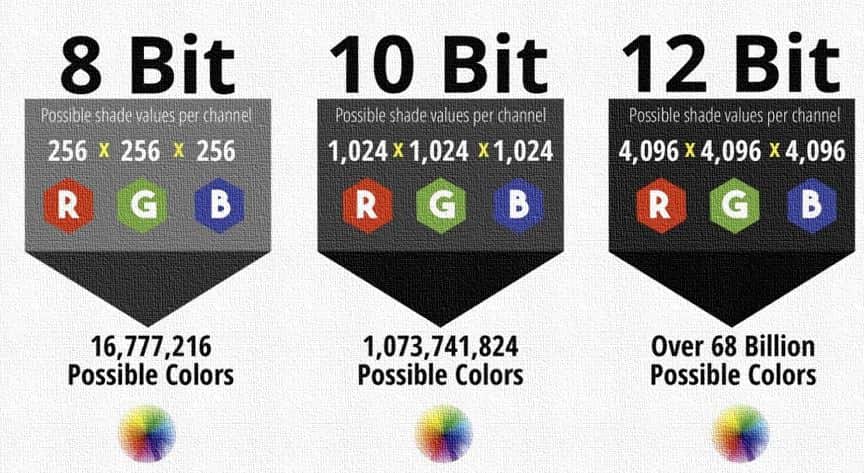The word “Color Depth” comes to our mind while selecting electronics having screens such as a laptop, mobile phone, computer, or television. But what exactly is color depth? What are bits and pixels? Are they related and what is their significance? Let’s find out.
The meaning of color depth
In simple language, a color depth which is also known as bit depth or pixel depth is actually a unit of measurement which relates directly to the number of colors that can be displayed on a screen. So basically, it means a number of bits per pixel. For example, color depth can be 8-bit,10-bit, etc. The more bits per pixel, the higher will be the color variety and quality of the monitor. The various bit color depth which the monitors support are:
- 1-bit color depth = 2 colors of each primary color shade
- 8-bit color depth = 256 colors “
- 10-bit color depth = 1,024 colors “
- 12-bit color depth = 4,096 colors “
- 16-bit color depth = 65,536 colors “
- 24-bit color depth = 16.7 million colors “
True color or 24-bit color is the most frequently used mode by most companies.
The relevance of color depth
The color depth is very important because the higher the color depth the more the number of colors that can be displayed on the screen. The color depth of an image indicates how many colors are available for each pixel. This means 1-bit of color depth will have only two colors i.e., black and white or what we call monochrome, 2-bit would be greyscaled, and 8-bit would be 256 color scale.
For photographers, the color depth is of great relevance especially for shooting portraits, as a higher color depth produces smoother transition between different skin tones. Even in normal photos, the colors appear close to reality.
Does a display of a TV or monitor with a high number of bits always offer a high color depth picture?
No, because in addition to the television or computer screen, the source material must also have this color depth. So, you have to use games, pictures, or videos that also offer a color depth of 10 bits or higher. It is very necessary for the source material along with the television or computer screen as then only in the display will the color appear to be very real. So, one can include HDR or Dolby Vision content to get a better display, which appears closer to reality. For computers and monitors, 10-bit or higher color depth is good
Let’s find out if higher color depth is always better or not
10-bit colors tend to look better than 8-bit colors, in any case, they allow more gradations, a larger contrast range, and expanded display options. Often 10 bits are used for a realistic representation, 8 bits look more “cartoonish”. To a certain extent, this is also a question of taste.
Though any higher bit – color will always give a better range of brightness, expanded display options, larger contrast range, and allow more gradations, than the lower bit – color, it definitely takes up more space. This is because higher color depth means more data.
Sometimes the bit color may not be high but the images are very bright and of high precision and this is due to a big factor called brightness encoding or Gamma correction. In big production workstations, as there is more availability of storage, they would use a high color-bit in their recording camera. So, the high color depth is not always better unless storage space is available.
Find out when is television or monitor with a high color depth required
When one uses a computer for recording and requires color-rich and high-resolution images and also using it for editing or playing HDR videos, then definitely a monitor with high color depth is required. Even if one wants to enjoy watching films in HDR or want to have a luxurious experience of home cinema, one should definitely choose a high color depth television.
Monitors for graphic designing, video editing, 3D animation, and other creative task does not need a monitor with such high color depth. So, one needs to be very mindful when selecting a monitor and its color depth.
Summary
- Color depth, basically also known as bit depth, is a unit of measurement and it determines how many colors can be displayed on the screen. The more bits per pixel, the higher will be the color variety and quality of the monitor.
- The color depth of an image indicates how many colors are available for each pixel. A high color depth avoids banding effects and there is a detailed display of dark and light areas in an image or video.
- Color depth is of great relevance and importance for people in the photography profession or video making and editing.
- Along with the computer screen or television, the source material i.e., content should also have a high color depth to make the display look very real.
- A higher color depth will no doubt give a better, bright image, layered contrast range, and expanded display option, but it also means more data and thus will take up more space.
- Television, monitor and screen with high color depth is mostly required for recording purpose, where color-rich and high-resolution images are required and also for photography and similar other creative tasks. It is also best suited for a home theatre experience.

Related Posts
What is a juice-jacking attack? How can we be safe from such attacks?
Getting the right dashcam for your needs. All that you need to know
WhatsApp iPad App Gets Major Overhaul, Adds New Communities Feature
Moto G85 5G launched in India but is unlikely to beat VIVO or XIAOMI
Rise of deepfake technology. How is it impacting society?
Smartphone Apps Get Smarter- Meta AI’s Integration Across Popular Platforms